-
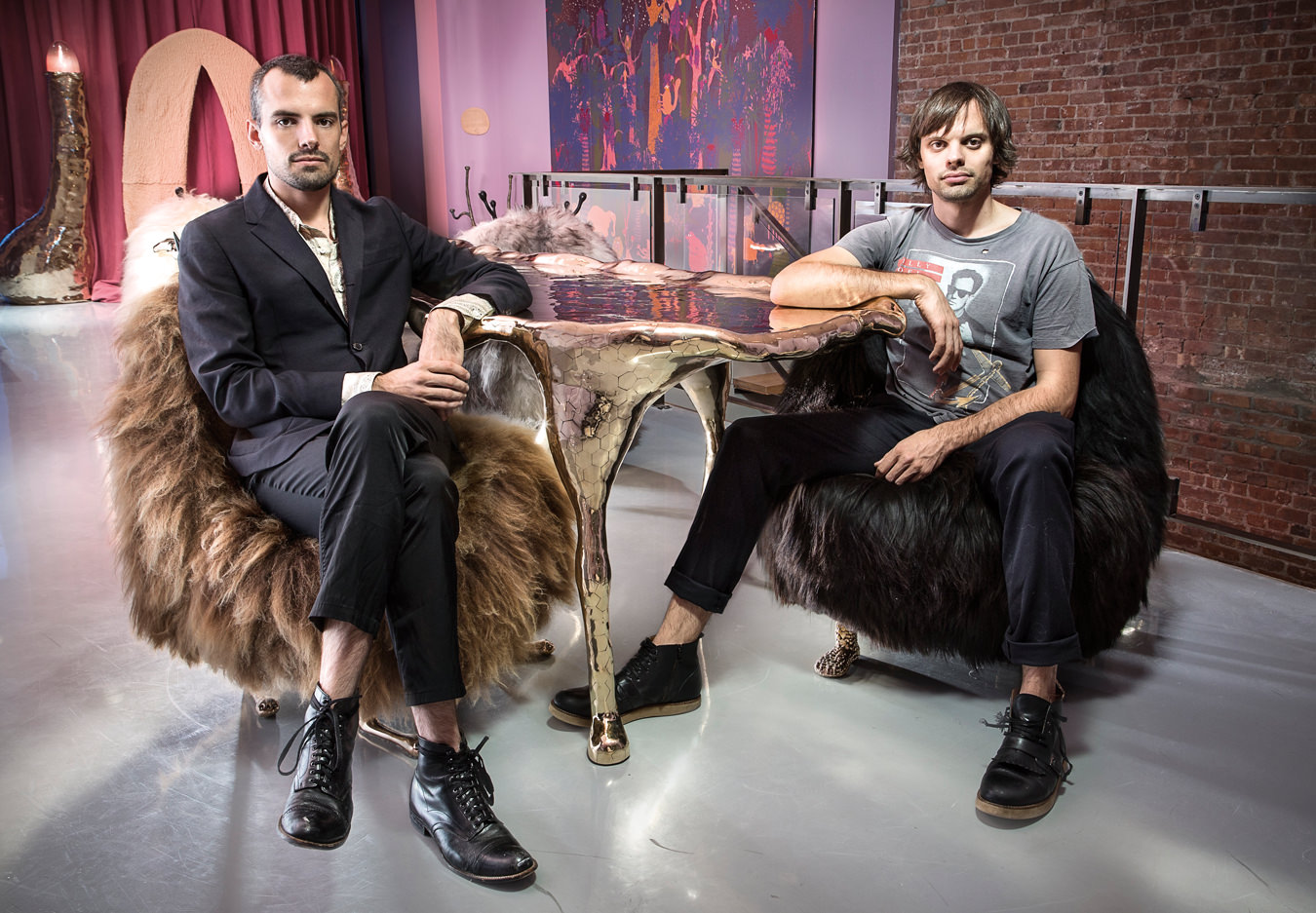
Design duo Simon and Nikolai Haas.
-
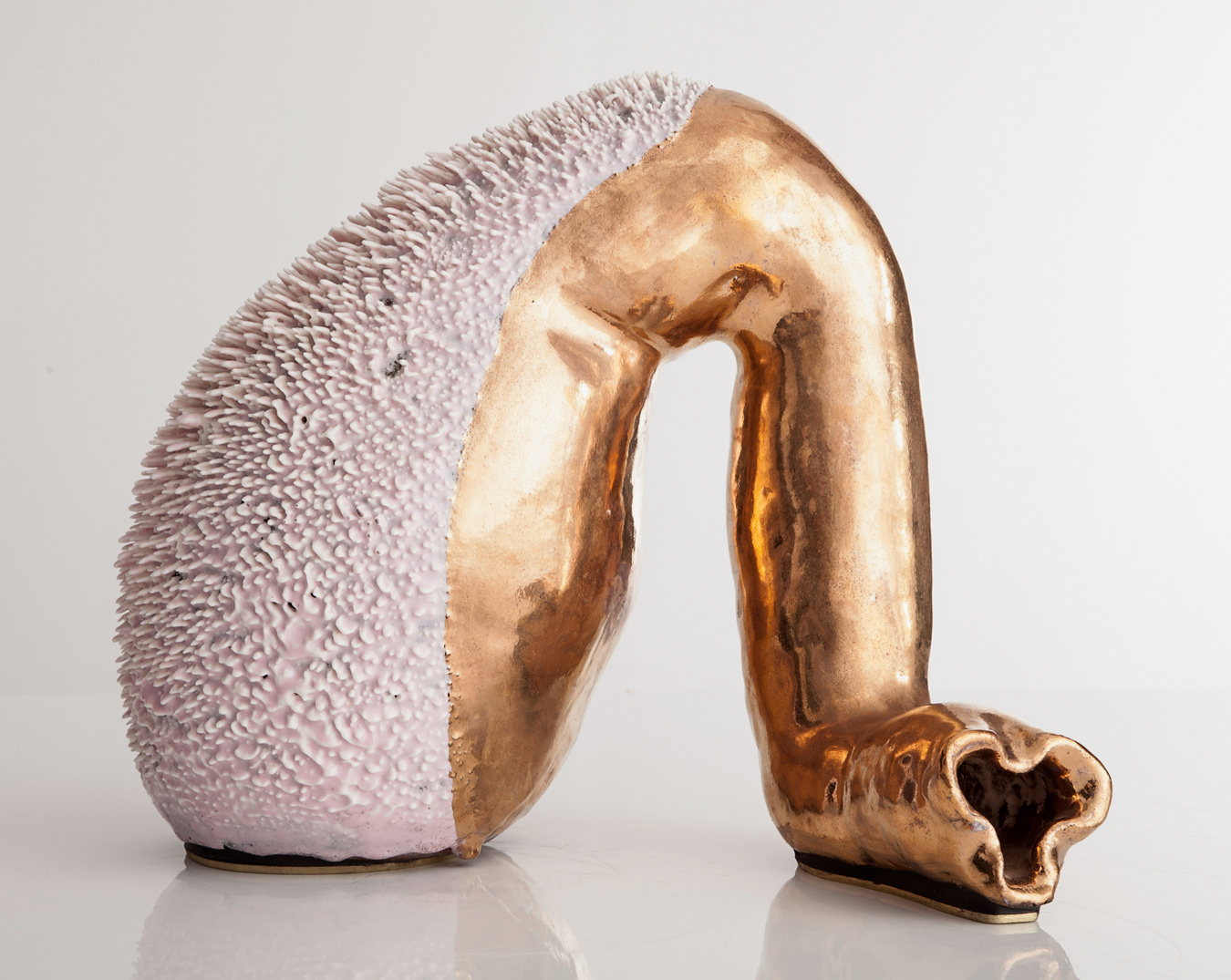
Long Hanging Dong from the Accretion series.
-

Snuffy Mini Beast with mini cheetah feet.
-
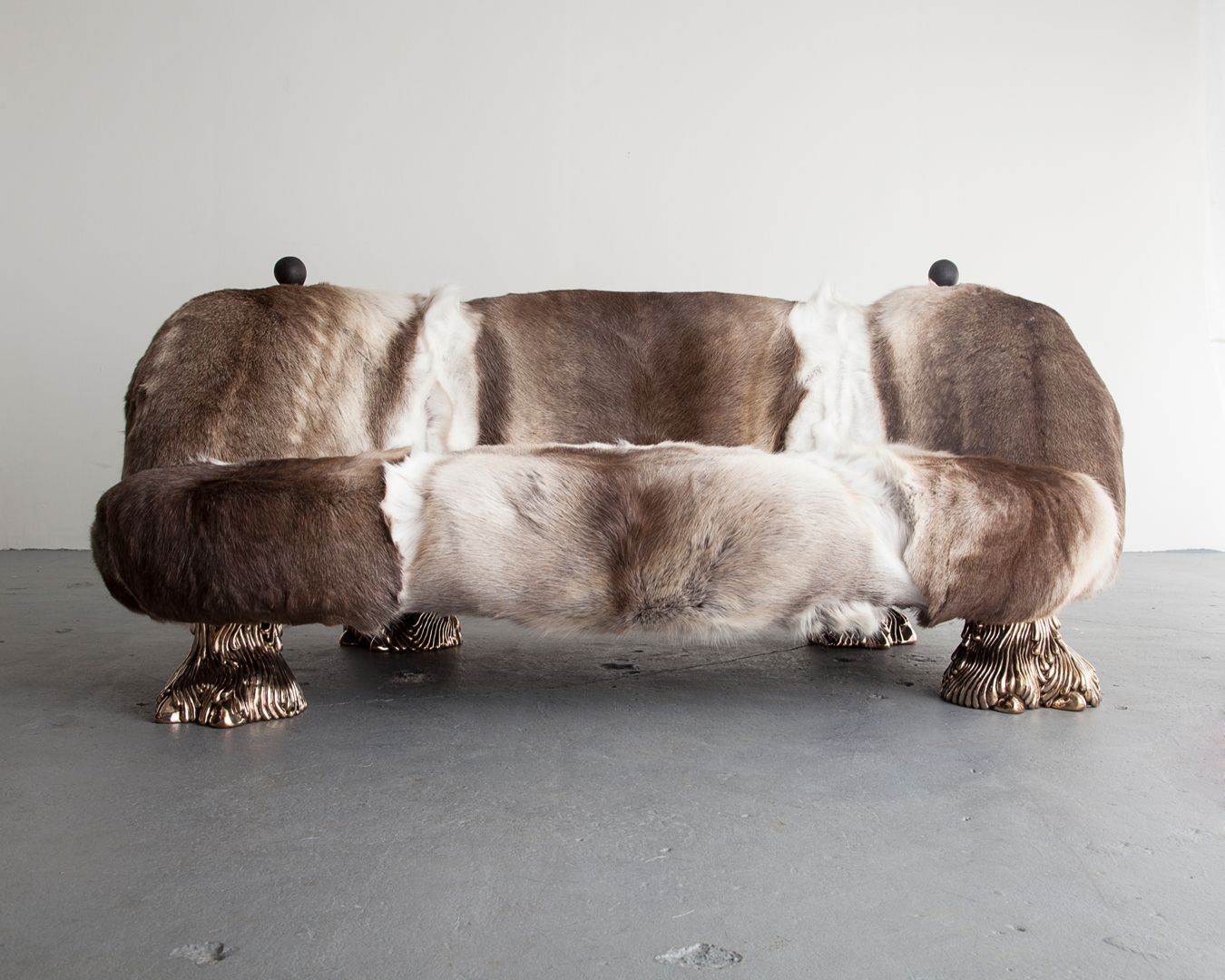
Beast Setee.
-
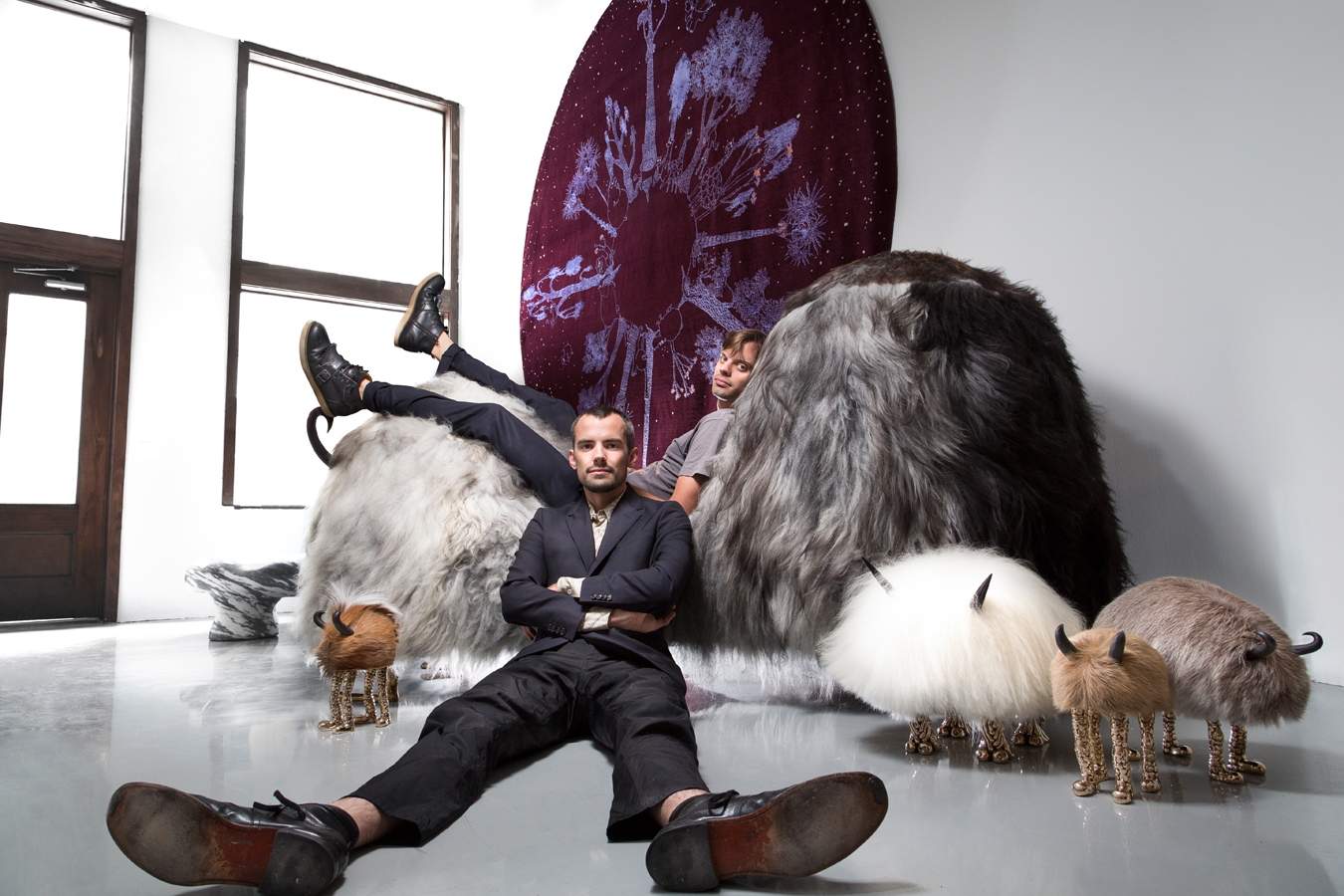
Simon and Nikolai in a world their own.
-
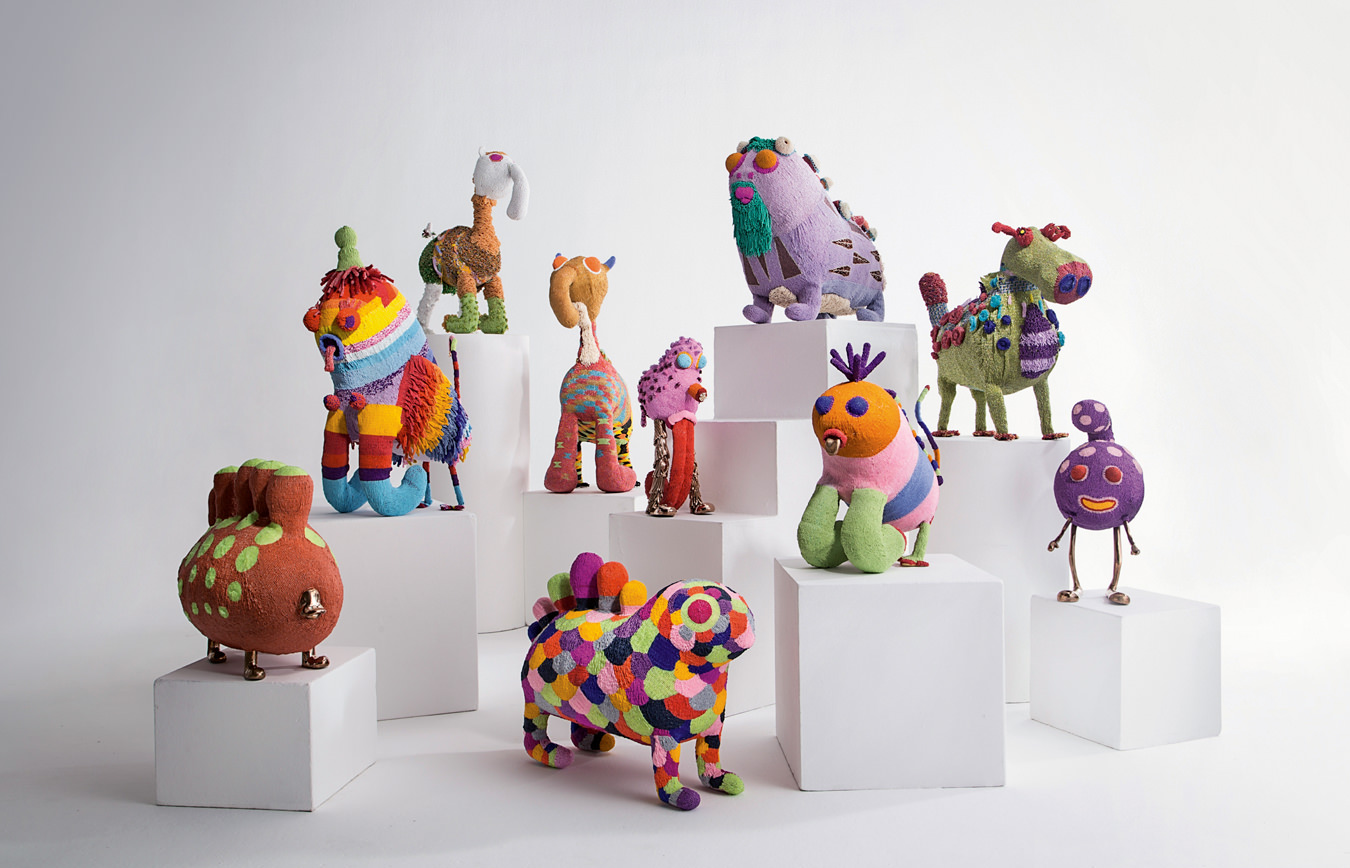
Assorted beaded works from the Afreaks series, created by the Haas Brothers and the Haas Sisters.
-

Sir Hiss Hex snake floor lamp.
-

Black Beast Club Chair and Foot Stool.
The Haas Brothers
Wonder boys of the design world.
One of their Accretion vases is, aptly, titled Long Hanging Dong and its shaft is roughly beaded to the point of furry. They’ve also made a furry chaise longue, poufs that resemble high-end Tribbles (yes, the Star Trek characters), and a chair with brass testicles that they hope users feel free to fondle. Since establishing their design, art, and fabrication studio in 2010 at the age of 26, Los Angeles–based fraternal twins Simon and Nikolai Haas have turned a lot of people on. Now, the keywords used by one art-world website to categorize their work include “craftsmanship and design”, “imaginary creatures”, and, naturally, if you know their work, “bulbous”. They have sculpted wax candles based on a set of cast bronze vases called the Hematite Vases that they describe as having “kind of an intestinal look” and, introducing a Christmas ornament they designed for the Los Angeles County Museum of Art, their website reads: “Is it a dragon tear? Is it a frozen plume of water? Is it a beautiful translucent ball sack?” Experimenting with materials ranging from resin and cast bronze to Wyoming buffalo fur, polyurethane, and clay, the Haas brothers have designed furniture, T-shirts, interiors, bondage pumps, and silk boxer shorts, all for Versace, and a retail ceiling for Guerlain. Mario Testino, Lady Gaga, and Louis Vuitton have commissioned them to do set and prop design and one-off garments. On the walls of the Ace Hotel Downtown Los Angeles, they sketched graphite “hieroglyphs” and comical portraits that both roast and reify the city’s ubiquitous celebrity murals. At least once, they have mentioned that they would like to do more architecture and filmmaking.
Instead of siloing their skills or limiting themselves to certain media, the brothers trawl for new tools and materials in 360 degrees, moving from furniture to film with alacrity. “Niki [Nikolai] and I have never been ones to limit ourselves,” Simon says. “I never found the idea of staying consistent in one’s work very interesting: if I had wanted to keep churning out the same thing day after day, I would have stayed a line cook. We are insatiable makers. If you put a napkin in front of me, it won’t be a napkin by the time dinner is over.” Simon paints evocative portraits and nudes in oil while Nikolai sketches in graphite plump animals in their birthday suits, or sculpts said creatures in epoxy clay before translating them into various 2- or 3-D materials.
This December, New York’s R & Company design gallery will mount Afreaks, an exhibition of the duo’s work made in collaboration with the South African master beaders who created work for the non-profit organization Monkeybiz at their booth at Design Miami. (It will open in New York at the Cooper Hewitt, Smithsonian Design Museum in February, before travelling on to Helsinki’s Design Museum in October 2016.) The beaders—who became known as the Haas Sisters during their work with the brothers—crafted a menagerie from the brothers’ fabulous bestiary. “Our studio is rooted in self-expression,” Nikolai explains. “We just utilize whichever medium or language suits what it is we’re trying to express. But the medium is a means to an end. For me, treating a medium as boundary can make the expression laborious.” Simon is always inventing new material processes or a new conceptual basis for creating objects, he says, “which is like trying out new colloquialisms in conversation. It can make the expression more eloquent, more concise, more original. I think it marks where we are coming from and highlights the capabilities of our time and this generation.”
The brothers were born in Los Angeles in 1984, but raised in Austin, Texas, by an opera singer (mother) and a sculptor and stone carver (father), who helped them to master construction and “material manipulation” at an early age. Later, Simon studied for two years at the Rhode Island School of Design while Nikolai toured as a musician with artists including Vincent Gallo, Sean Lennon, and Jim O’Rourke. In 2007, after Nikolai turned down a college hockey scholarship and Simon skipped out of RISD, the twins reconnected in L.A. (where their older brother, actor Lukas Haas, also lives) and began to tour with Gallo’s experimental band Rriiccee. “Vincent taught us both that you can pretty much accomplish anything, but that it takes tons and tons of consistent effort,” Simon says. “He taught us how to protect ourselves from business vultures. He taught us how to be okay with haters. But he also made me understand that I am completely responsible for everything good and bad that happens to me in my life.”
It was a 2009 collaboration with architectural firm Johnston Marklee that spurred them to set up shop the following year in a concrete and exposed brick warehouse downtown. The studio is very much a workshop where ideas are forged in the making, colourful amidst shelves of hand-mixed glazes, their handwritten labels noting the chemical formulae of the contents. They make many pieces themselves, but they will be the first to point out that they are usually not masters of the media in which they work (at the beginning). They also work with makers who include, but are not limited to, potters, the aforementioned beaders, seamstresses, glassblowers, and metalworkers. They draw on a big chalkboard and pin ink sketches and inspirations to the walls, which, last year, meant photos of naked people and tight close-ups of penises and vaginas.
The Haas brothers’ work contains self-completing dichotomies: it can be playful and philosophical, unselfconsciously sweet and pornographic.
Los Angeles offers the two a combination of opportunities to experience the urban between hikes in the Angeles National Forest and trips to the desert; to enjoy exposure (the coast) and intimacy (“the hills that hug the city”); the sociability of a beloved community of family and friends; and solitude. Turns out, a car stuck in traffic is a great place to finally listen to a whole album in one go: “Rush hour is an attitude,” Simon says, “not a condition.” It’s also a pot smoker’s city, not a cokehead’s, and this, too, they will be quick to tell you, explains their fondness for it.
In just five years, the Haas’s work has become sought after for its craftsmanship, material experimentation, psychotropic and anthropomorphic whimsy, and its fluency in design, art, fashion, and fabrication. Their artistic extroversion and creative catholicism underscore an eagerness to absorb anything that is unfamiliar. Nikolai describes himself as a cartoonist and sculptor and Simon as a philosopher and scientist: “Each time he makes a discovery, it bends my mind just a little,” says Nikolai. Simon would use the phrase “mad scientist”. Lying in bed at night, Simon tends to think up unlikely tests of materials and “obsesses over every possible way” to, say, stitch beads together: “I have an intuition with material, like I can speak with it and find out what it can do that it hasn’t been showing us. I’m also obsessed with the idea of repetition and the way it reveals chaos.” For example, that one action performed 1,000 times will have a slightly different result than a repetition of that same set of 1,000 a second time. Simon is also a proud generalist. “I like this term because it indicates that I’m interested in all things,” he says. “It also tells you that I’m not a specialist, because I’m not.”
In general, Nikolai’s formal obsessions lend flesh to their work while Simon’s material obsessions—dripping resin through pantyhose or finding a way to bend hexagonal brass tiles over a voluptuous form—frame it. “What drives me to experiment is that I want to know the materials so well that an experiment becomes unnecessary,” Simon says. He conceived of their beady Accretion vase texture, for example, because he wanted to better understand the character of clay. He noticed that ceramic slip dries quickly and that brushing it onto a dry vessel causes the brush to stick and drag, making it difficult to achieve an even coat.
“This unevenness, the dry stickiness I felt in my brush, was an action that the material itself was begging to perform.” He tried brushing the clay on in “thousands of layers”, letting the uneven texture become the foundation for further uneven accretion. “On each test I would use slightly more or less pressure, a wider or thinner brush, a different angle of inclination, while brushing. What resulted from the myriad tests is a texture that is really just an example of a material forming itself, like a geological process except that the human hand replaces the environmental factors that would determine the shape, say, of a mountain.”
Since then, the process has inspired and been used to create not one but several bodies of work. Most of the time, the brothers’ interests and skills prove complementary. Everything they make is discussed as they make it. Simon will show Nikolai a new material; Nikolai will show Simon new concepts and forms. Everything they talk about will be tested or made, and then they decide, together, which experiments worked and which did not.
Perhaps the fact that they are not, and do not look, identical, has allowed them to grow into two distinct halves of a fraternal whole—always able to overlap at will—instead of flip sides of the same coin. Nikolai’s features are looser and fuller, his limbs slightly longer, his eyes sometimes set into dark circles under a baseball cap. Simon’s face is longer, his features drawn more finely, his hair wavy and thicker. Nikolai, who is straight (like his hair), looks like a rock star; Simon, who is gay, has the look of a movie star, his face sometimes forming a mask. Even at rest, Nikolai’s face can’t seem to rid itself of expression.
The brothers’ work contains similar self-completing dichotomies: it can be playful and philosophical, unselfconsciously sweet and pornographic. Their innocuously phallic objects co-exist with elements that are hard, big, or pointed. The otherwise cuddly Beast club chairs have carved ebony horns. Animal Party, their glow-in-the-dark wallcovering produced by Flavor Paper, is set in a forest that might feel menacing but for the cartoonish canoodling of the chubby elephants, ruffled gnus, and sleepy leopards who form its unusually long repeat. And when the black light goes on, those who look closely enough will find bottoms, breasts, and a goofy hippopotamus with softly furred genitals getting drunk off fermented fruit. “I would describe our work as human and youthful,” says Simon. “We strive to make objects that have emotional impact, and whether this comes in the form of a joke or a head-scratcher, if an object makes us feel something, then we like that object.” At first glance, the naughtiness might be mistaken for provocation, but its self-awareness and frank delight in having fun makes it difficult to find the sweetness saccharine or the body parts vulgar. In the Haas’s work, sex is the same as, not the opposite of, love: good humoured, joyful, and wholly relevant, every day.
At the threshold of their Advocates for the Sexual Outsider exhibition at R & Company’s booth at Design Miami/Basel in 2014, their person-size, cast-bronze Dong torchieres snuggled up to a doorway made from vermiculated leather. Handwritten wall text detailed their manifesto in plain language. A part of it states: “As humanists, we feel that shame is one of the most counterproductive emotional states for human development … We believe that sex is an extension of innocence, not a loss of it.”
From the beginning, it has been crucial to both men that people relate to their work on a personal level, which means that sex is, naturally, a large part of their focus. Animals and sex figured largely among the themes of ancient art, as they do in theirs, Simon points out; “and I think it is as simple as wanting to represent in our work what we experience in the world. We aren’t responding to our culture’s puritanism, we just ignored it from the beginning.” The work is both soft and hard, perhaps seeking a constant imbalance. “You know how perfumers will add molecules of feces, blood, or urine to a perfume to give it the je ne sais quoi that elevates it to a beautiful scent? It is always good to temper something you have in spades with something that counteracts but complements it. The niceness is something we both have in spades. We just want to make loveable things.”




